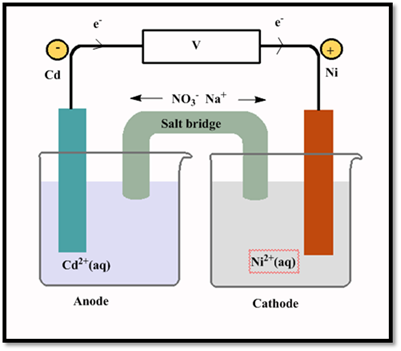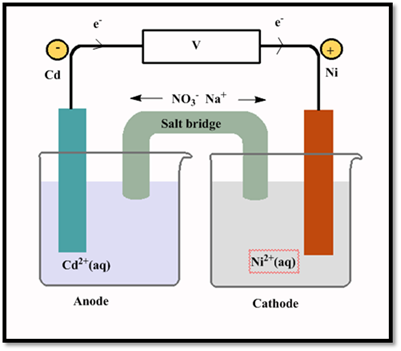
Concept explainers
Consider an
- (a) Diagram the cell, and label each of the components (including the anode, cathode, and salt bridge).
- (b) Use the equations for the half-reactions to write a balanced, net ionic equation for the overall cell reaction.
- (c) What is the polarity of each electrode?
- (d) What is the value of E°cell?
- (e) In which direction do electrons flow in the external circuit?
- (f) Assume that a salt bridge containing NaNO3 connects the two half-cells. In which direction do the Na+(aq) ions move? In which direction do the NO3− (aq) ions move?
- (g) Calculate the equilibrium constant for the reaction.
- (h) If the concentration of Cd2+ is reduced to 0.010 M and [Ni2+] = 1.0 M, what is the value of Ecell? Is the net reaction still the reaction given in part (b)?
- (i) If 0.050 A is drawn from the battery, how long can it last if you begin with 1.0 L of each of the solutions and each was initially 1.0 M in dissolved species? Each electrode weighs 50.0 g in the beginning.
(a)
Interpretation:
The half reactions are as follows.
The cell has to be drawn and label each of the component.
Concept introduction:
Voltaic cell or Galvanic cell:
The device to produce electricity by using chemical reactions. In these divces are redox chemical reactions are occured.
A voltaic cell converts chemical energy into electrical energy.
It consists of two half cells. Each half cell consists of a metal and a solution of a salt of metal. Two half cells are connected by salt bridge.
The chemical reaction in the half cell is an oxidation reduction (redox)reactions.
For example:
Cell diagram of voltaic or galvanic cell is as follows.
Answer to Problem 105IL

Explanation of Solution
The half reactions are as follows.
The voltaic cell are as follows:

(b)
Interpretation:
To determine the following.
The half reactions are as follows.
The balance equation has to be given.
Concept introduction:
Voltaic cell or Galvanic cell:
The device to produce electricity by using chemical reactions. In these divces are redox chemical reactions are occured.
A voltaic cell converts chemical energy into electrical energy.
It consists of two half cells. Each half cell consists of a metal and a solution of a salt of metal. Two half cells are connected by salt bridge.
The chemical reaction in the half cell is an oxidation reduction (redox)reactions.
For example:
Cell diagram of voltaic or galvanic cell is as follows.
Answer to Problem 105IL
Balanced reaction:
Explanation of Solution
Let’s write the half reactions occur at anode and cathode:
By adding these two half reactions we get balanced reaction.
(c)
Interpretation:
The half reactions are as follows.
The polarity of each electrode has to be determined.
Concept introduction:
Voltaic cell or Galvanic cell:
The device to produce electricity by using chemical reactions. In these divces are redox chemical reactions are occured.
A voltaic cell converts chemical energy into electrical energy.
It consists of two half cells. Each half cell consists of a metal and a solution of a salt of metal. Two half cells are connected by salt bridge.
The chemical reaction in the half cell is an oxidation reduction (redox)reactions.
For example:
Cell diagram of voltaic or galvanic cell is as follows.
Answer to Problem 105IL
Anode is negative cathode is positive.
Explanation of Solution
In the voltaic cell has two voltaic cells. One electrode has positive charge called cathode and another electrode has negative called anode.
(d)
Interpretation:
The half reactions are as follows.
The
Concept introduction:
Voltaic cell or Galvanic cell:
The device to produce electricity by using chemical reactions. In these divces are redox chemical reactions are occured.
A voltaic cell converts chemical energy into electrical energy.
It consists of two half cells. Each half cell consists of a metal and a solution of a salt of metal. Two half cells are connected by salt bridge.
The chemical reaction in the half cell is an oxidation reduction (redox)reactions.
For example:
Cell diagram of voltaic or galvanic cell is as follows.
Answer to Problem 105IL
Explanation of Solution
The reactions occur at anode and cathode is as follows.
Let’s calculate the
(e)
Interpretation:
The half reactions are as follows.
The direction in which electrons flow in the external circuit has to be given.
Concept introduction:
Voltaic cell or Galvanic cell:
The device to produce electricity by using chemical reactions. In these divces are redox chemical reactions are occured.
A voltaic cell converts chemical energy into electrical energy.
It consists of two half cells. Each half cell consists of a metal and a solution of a salt of metal. Two half cells are connected by salt bridge.
The chemical reaction in the half cell is an oxidation reduction (redox)reactions.
For example:
Cell diagram of voltaic or galvanic cell is as follows.
Answer to Problem 105IL
Electrons are flow from anode to cathode.
Explanation of Solution
In the voltaic cell electrons are move anode to cathode.
(f)
Interpretation:
To determine the following.
The half reactions are as follows.
Assume that a salt bride containing
Concept introduction:
Voltaic cell or Galvanic cell:
The device to produce electricity by using chemical reactions. In these divces are redox chemical reactions are occured.
A voltaic cell converts chemical energy into electrical energy.
It consists of two half cells. Each half cell consists of a metal and a solution of a salt of metal. Two half cells are connected by salt bridge.
The chemical reaction in the half cell is an oxidation reduction (redox)reactions.
For example:
Cell diagram of voltaic or galvanic cell is as follows.
Answer to Problem 105IL
Explanation of Solution
Salt bridge contains
(g)
Interpretation:
The half reactions are as follows.
The equilibrium constant has to be determined.
Concept introduction:
Voltaic cell or Galvanic cell:
The device to produce electricity by using chemical reactions. In these divces are redox chemical reactions are occured.
A voltaic cell converts chemical energy into electrical energy.
It consists of two half cells. Each half cell consists of a metal and a solution of a salt of metal. Two half cells are connected by salt bridge.
The chemical reaction in the half cell is an oxidation reduction (redox)reactions.
For example:
Cell diagram of voltaic or galvanic cell is as follows.
Answer to Problem 105IL
The equilibrium constant of the reaction is
Explanation of Solution
(h)
Interpretation:
The half reactions are as follows.
If the concentration of
Concept introduction:
Voltaic cell or Galvanic cell:
The device to produce electricity by using chemical reactions. In these divces are redox chemical reactions are occured.
A voltaic cell converts chemical energy into electrical energy.
It consists of two half cells. Each half cell consists of a metal and a solution of a salt of metal. Two half cells are connected by salt bridge.
The chemical reaction in the half cell is an oxidation reduction (redox)reactions.
For example:
Cell diagram of voltaic or galvanic cell is as follows.
Answer to Problem 105IL
Explanation of Solution
Net reaction will be still given in part (b)
(i)
Interpretation:
The half reactions are as follows.
The time the battery will last if
Concept introduction:
Voltaic cell or Galvanic cell:
The device to produce electricity by using chemical reactions. In these divces are redox chemical reactions are occured.
A voltaic cell converts chemical energy into electrical energy.
It consists of two half cells. Each half cell consists of a metal and a solution of a salt of metal. Two half cells are connected by salt bridge.
The chemical reaction in the half cell is an oxidation reduction (redox)reactions.
For example:
Cell diagram of voltaic or galvanic cell is as follows.
Answer to Problem 105IL
The time required for the electrolysis is
Explanation of Solution
Let’s calculate the charge of the cell:
Therefore, the time can be calculated as follows.
Want to see more full solutions like this?
Chapter 19 Solutions
Owlv2 With Ebook, 1 Term (6 Months) Printed Access Card For Kotz/treichel/townsend/treichel's Chemistry & Chemical Reactivity, 10th
- At an electrified interface according to the Gouy-Chapman model, what types of interactions do NOT occur between the ions and the solvent according to this theory?arrow_forwardPlease predict the products for each of the following reactions. Clearly show the regiochemistry (Markovnikov vs anti-Markovnikov) and stereochemistry (syn- vs anti- or both). If a mixture of enantiomers is formed, please draw all the enantiomers. Hint: In this case you must choose the best answer to demonstrate the stereochemistry of H2 addition. 1.03 2. (CH3)2S BIZ CH₂OH 2. DMS KMnO4, NaOH ΖΗ Pd or Pt (catalyst) HBr 20 1 HBr ROOR (peroxide) HO H-SO HC 12 11 10 BH, THE 2. H2O2, NaOH Brz cold HI 19 18 17 16 MCPBA 15 14 13 A Br H₂O BH3⚫THF Brz EtOH Pd or Ni (catalyst) D₂ (deuterium) 1. Os04 2. H2O2 CH3CO3H (peroxyacid) 1. MCPBA 2. H₂O* H B + H H H "H C H H Darrow_forwardExplain how Beer’s Law can be used to determine the concentration in a selected food sample. Provide examples.arrow_forward
- Explain the importance of having a sampling plan with respect to food analysis. Explain the importance of having a sampling plan with respect to food analysis. Provide examples.arrow_forwardPlease predict the products for each of the following reactions. Clearly show the regiochemistry (Markovnikov vs anti-Markovnikov) and stereochemistry (syn- vs anti- or both). If a mixture of enantiomers is formed, please draw all the enantiomers. cold KMnO4, NaOH 2. DMS 1. 03 CH3OH Br2 1. 03 2. (CH3)2S H₂ Pd or Pt (catalyst) HBr 18 19 20 1 HBr ROOR (peroxide) H₂O H₂SO4 HCI HI 17 16 6 15 MCPBA 1. BH3 THF 2. H₂O2, NaOH 1. OsO4 2. H₂O₂ 110 CH3CO₂H (peroxyacid) 1. MCPBA 2. H₂O* Br2 H₂O BH3 THF B12 EtOH Pd or Ni (catalyst) D₂ (deuterium) Bra A B C D H OH H OH OH H OH α α α OH H OH OH фон d H "Harrow_forwardBriefly indicate the models that describe the structure of the interface: Helmholtz-Perrin, Gouy-Chapman, Stern and Grahame models.arrow_forward
 Chemistry: Principles and ReactionsChemistryISBN:9781305079373Author:William L. Masterton, Cecile N. HurleyPublisher:Cengage LearningChemistry: Matter and ChangeChemistryISBN:9780078746376Author:Dinah Zike, Laurel Dingrando, Nicholas Hainen, Cheryl WistromPublisher:Glencoe/McGraw-Hill School Pub Co
Chemistry: Principles and ReactionsChemistryISBN:9781305079373Author:William L. Masterton, Cecile N. HurleyPublisher:Cengage LearningChemistry: Matter and ChangeChemistryISBN:9780078746376Author:Dinah Zike, Laurel Dingrando, Nicholas Hainen, Cheryl WistromPublisher:Glencoe/McGraw-Hill School Pub Co Chemistry: The Molecular ScienceChemistryISBN:9781285199047Author:John W. Moore, Conrad L. StanitskiPublisher:Cengage Learning
Chemistry: The Molecular ScienceChemistryISBN:9781285199047Author:John W. Moore, Conrad L. StanitskiPublisher:Cengage Learning Principles of Modern ChemistryChemistryISBN:9781305079113Author:David W. Oxtoby, H. Pat Gillis, Laurie J. ButlerPublisher:Cengage Learning
Principles of Modern ChemistryChemistryISBN:9781305079113Author:David W. Oxtoby, H. Pat Gillis, Laurie J. ButlerPublisher:Cengage Learning ChemistryChemistryISBN:9781305957404Author:Steven S. Zumdahl, Susan A. Zumdahl, Donald J. DeCostePublisher:Cengage Learning
ChemistryChemistryISBN:9781305957404Author:Steven S. Zumdahl, Susan A. Zumdahl, Donald J. DeCostePublisher:Cengage Learning





